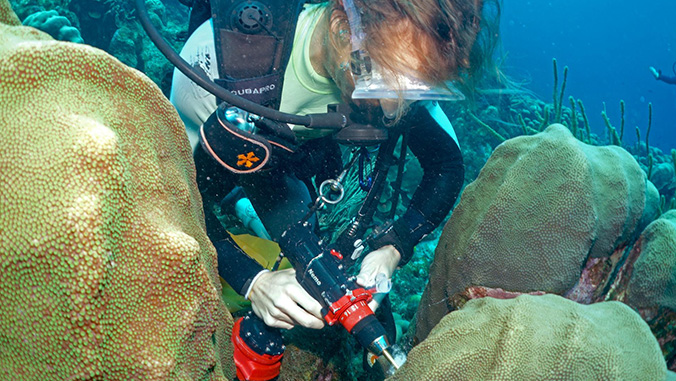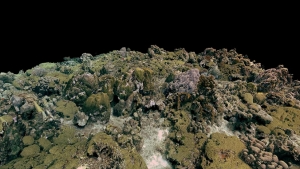New 3D Mapping Technique Reveals Hidden Microbial Communities On Coral Reefs
Researchers have created 3D molecular maps of bacteria, viruses and biochemicals across coral colonies along with their interacting organisms such as algae and other competing corals.
 Ty Roach takes a sample to study viruses, microbes and metabolites of coral. (Photo credit: Ben Mueller) Creating these maps allowed the team from the University of Hawaiʻi at Mānoa, University of British Columbia (UBC), San Diego State University (SDSU) and elsewhere to discover specific microbial and viral functions that appear to be key components of the coral microbiome.
Ty Roach takes a sample to study viruses, microbes and metabolites of coral. (Photo credit: Ben Mueller) Creating these maps allowed the team from the University of Hawaiʻi at Mānoa, University of British Columbia (UBC), San Diego State University (SDSU) and elsewhere to discover specific microbial and viral functions that appear to be key components of the coral microbiome.
The study, published in Frontiers of Marine Science, used a novel combination of state-of-the-art molecular methods with cutting-edge 3D imaging techniques to create high-resolution molecular maps of coral reef organisms.
 An endangered coral species, Acropora palmata. (Photo credit: Ben Mueller)
An endangered coral species, Acropora palmata. (Photo credit: Ben Mueller)
Healthy coral reefs require coral colonies that are resilient and outcompete other organisms such as algae. The new study builds on the authors’ previous research which highlighted the important role that viruses and bacteria play in mediating the clash between coral and algae on coral reefs.
“Our recent research extends this work into a spatially explicit framework and makes for some really impressive 3D molecular maps,” said Ty Roach, PhD, study senior author and post-doctoral researcher at the Hawaiʻi Institute of Marine Biology in UH Mānoa’s School of Ocean and Earth Science and Technology. “Further, we found that patterns in bacteria and viruses that live on and in corals were mainly driven by ecological factors such as how close to a competitor the sample was taken.”
This effort is an example of UH Mānoa’s goal of Excellence in Research: Advancing the Research and Creative Work Enterprise (PDF), one of four goals identified in the 2015–25 Strategic Plan (PDF), updated in December 2020.
Structure from motion photogrammetry and 3D molecular mapping
The team sampled two coral colonies from a Caribbean coral reef and made 3D reconstructions of the corals and their interacting organisms using a method called structure from motion photogrammetry. Multiple molecular methods were then used to investigate the bacterial and viral DNA, RNA and biochemicals that were associated with these corals. These molecules were then mapped back onto the 3D models.
“The current state of ecology has demonstrated that corals are home to millions of microbes and viruses, which exist in a complex biochemical milieu,” said Emma George, co-lead author of the study and doctoral candidate at UBC. “These viruses, microbes and chemicals in combination with the coral host form a unit called a holobiont. Understanding the roles of each of these players in ecosystem function has become increasingly important as coral reef health has begun to decline over recent decades.”
 A large-scale, 3D reconstruction of a coral reef. (Photo credit: Stuart Sandin)
A large-scale, 3D reconstruction of a coral reef. (Photo credit: Stuart Sandin)
Functional and healthy reef ecosystems protect coastlines, contribute to local economies and support marine food webs, including fisheries. The new findings have direct implications for coral reef restoration and management, as they provide a more mechanistic understanding of the way that local stressors affect corals and can lead to disease.
Furthermore, Roach highlights that, “the insight gained from this work is allowing us to design and test probiotic blends (blends of beneficial bacteria that can protect corals from local stressors) and phage therapies (blends of bacterial viruses (phage) that can restructure the bacterial community) for use on corals. In this way, we aim to utilize personalized medicine techniques to help corals gain an ecological advantage over competitors such as harmful algae.”
“Additionally, these 3D molecular mapping methods could be applied to many other ecologically important organisms, beyond corals,” said Mark Little, co-lead author of the study and doctoral candidate at SDSU. “It is our hope that this combination of methods to generate underwater molecular maps will be a fruitful way for others to better understand the holobiont of many marine animals and plants.”
–By Marcie Grabowski
Publication: Mark Little, et al. Three-Dimensional Molecular Cartography of the Caribbean Reef-Building Coral Orbicella faveolata. Frontiers of Marine Science, (2023). DOI: 10.3389/fmars.2021.627724
Original Story Source: University of Hawaii at Manoa

 Alerts Sign-up
Alerts Sign-up